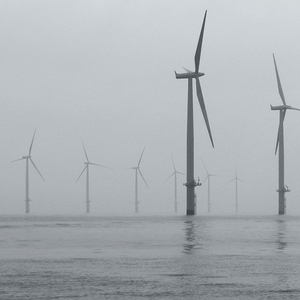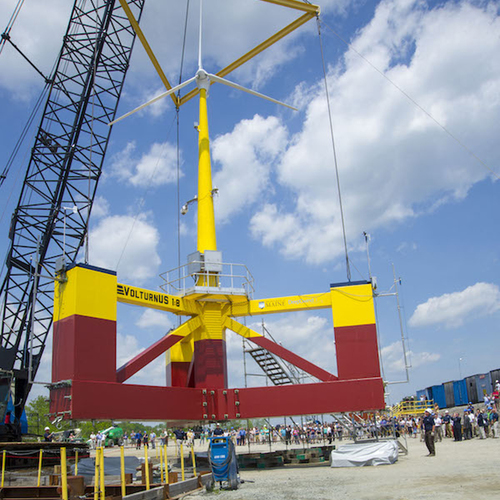Image Credit: University of Maine
Image Credit: University of Maine The innovative design of the VolturnUS combines composites developed at the University of Maine with a semi-submersible concrete base.
Image Credit: University of Maine
The country’s first grid-tied floating wind turbine, launched in Maine at the end of May, has started feeding electricity into the state’s power grid.
VolturnUS 1:8, a 1/8-scale prototype of a 6-megawatt design, was launched in Brewer, Maine, on May 31, 2013. It was towed down the Penobscot River and moored off the town of Castine. On June 13, electricity began flowing from the turbine into Central Maine Power Co.’s grid.
The 65-foot tall unit is equipped with a 20-kW turbine manufactured by Renewegy. A full-size turbine, the first of which could be launched by 2016, would have rotors with a diameter of 423 feet and would generate up to 6 megawatts of electricity.
Design combines concrete and composites
The launch capped five years of research at the University of Maine’s Advanced Structures and Composites Center in Orono.
Financial support included a $12 million grant from the U.S. Department of Energy. The effort led to the creation of the DeepCwind Consortium, which includes nonprofit groups and a variety of marine construction and manufacturing interests.
The turbine has a semi-submersible base made from a proprietary concrete and an upper structure of lighter-weight composite materials.
A foundation made from steel would have been a more conventional choice, says Elizabeth Viselli, manager of offshore wind programs and communications at the composites center, but Maine would have had to import that material from South Korea and it lacked the manufacturing facilities it needed to form curved steel components.
Concrete, on the other hand, is well understood, with ingredients that are locally available. The exact mix of concrete, which Viselli did not discuss, was developed at the University of Maine. The structure was fabricated by Cianbro Corp.
The Gulf of Maine has an estimated 156 gigawatts of wind energy potential within 50 miles of the coast, but Viselli says the depth of water 20 miles offshore where turbines will be deployed makes fixed designs like those in northern Europe impractical.
Much bigger plans in the works
Later this year, the VolturnUS will be towed to a site off Monhegan Island for more tests. These research sites relatively close to land are perfect, Viselli says, because waves and wind are about one-eighth as intense as what an offshore turbine would encounter.
The university hopes that the 2016 deployment of a full-size turbine would be the start of an offshore wind farm that will include 80 turbines by 2020. By 2030, the project would expand to about 170 turbines generating 5 GW of electricity, according to the Bangor Daily News.
Wind development on that scale would attract $20 billion in private investment and create thousands of jobs, the university says. To that end, the university is in the process of spinning off the wind generation business into a private venture called Aqua Ventus Holdings.
The Volturn project is part of a larger effort to develop an estimated 4,000 gigawatts of offshore wind energy, which the Department of Energy says is four times the country’s current generating capacity. In December, the energy department announced seven offshore wind awards.
The goal of the program in Maine is to reduce the cost of offshore wind electricity to 10 cents a kilowatt hour by 2020.
Weekly Newsletter
Get building science and energy efficiency advice, plus special offers, in your inbox.
















0 Comments
Log in or create an account to post a comment.
Sign up Log in